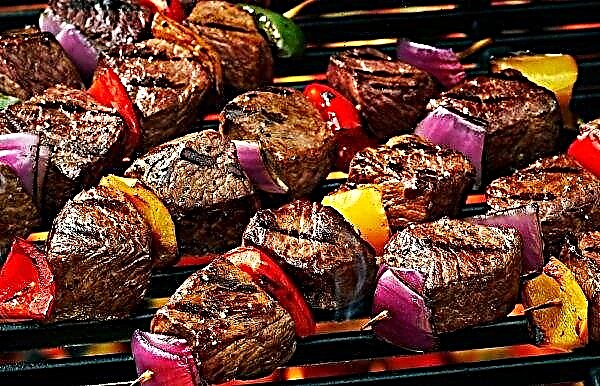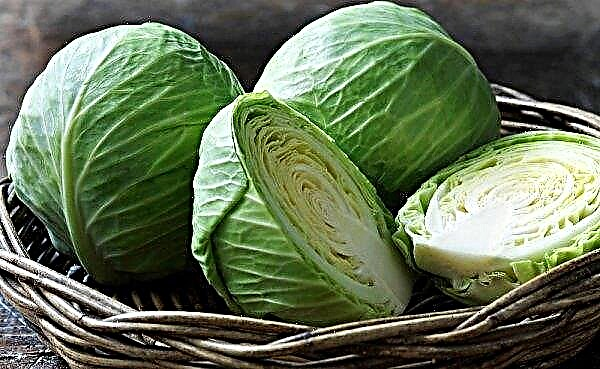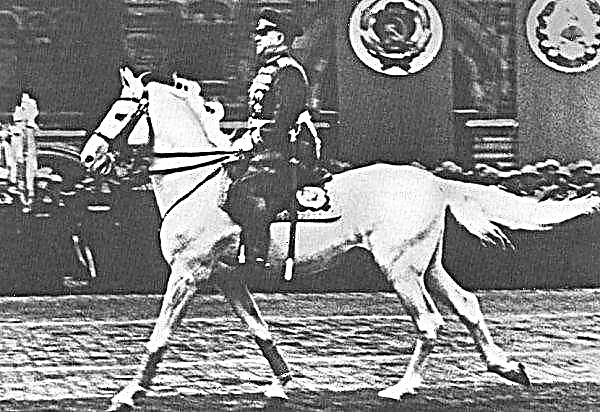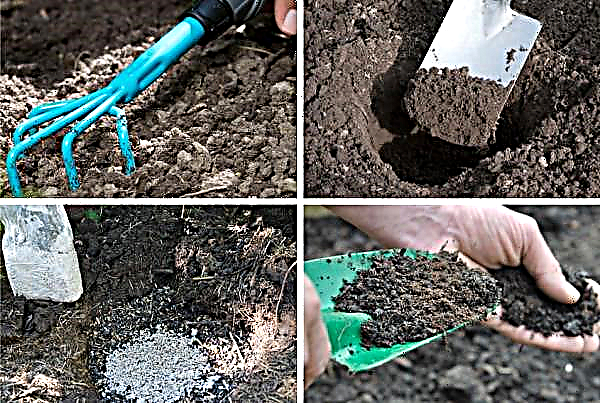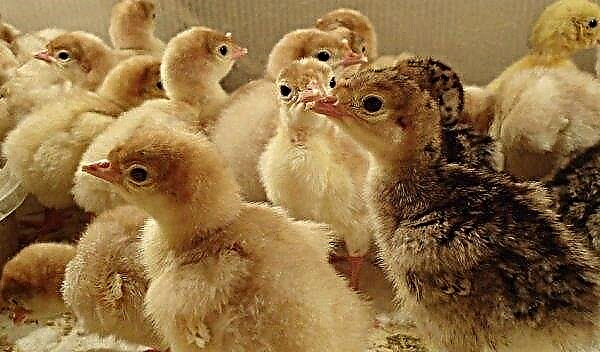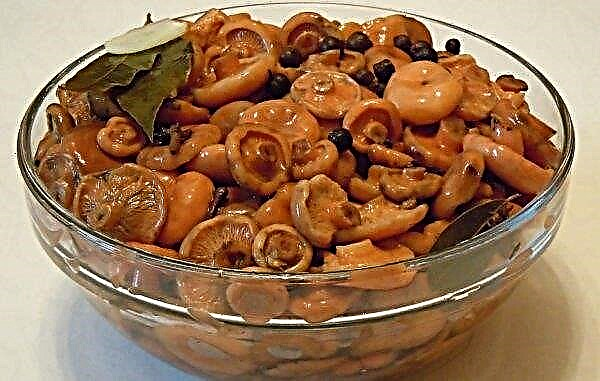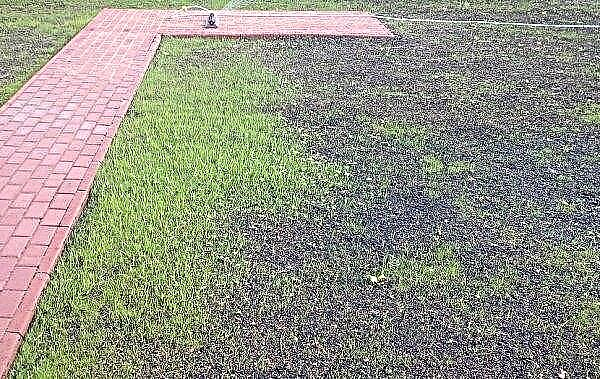The Karachaevskaya breed of sheep was bred about 200 years ago. It belongs to meat-and-milk and milk varieties, which differ in a rough wool coat. Read more about the pros and cons of the breed, as well as its main characteristics below.
Karachaevskaya breed of sheep
Karachaevsky sheep are one of the most ancient. It is noteworthy that they have an independent origin, and their genetics are completely different from modern representatives.
Breed history
The species of sheep under consideration was bred by folk selection in the high mountain Karachai near the estuaries of the Kuban River. The exact date of the appearance of the breed is not known, but already in the XIX century it was known about it outside the territory of the breeding.
Did you know? Sheep have rectangular pupils.
The main characteristics of the breed
Before you get cattle, you need to dwell in more detail on its characteristics and pedigree features. The species under consideration belongs to the coarse-haired type and the meat-and-milk-milk direction. Individuals adapt perfectly in cool climates, feel good with high humidity. They are distinguished by good immunity - they are not subject to pathologies of the respiratory system and limbs. Sick and weak lambs are born very rarely.
Video: Karachaevskaya breed of sheep
Appearance and description
The sheep of this breed are distinguished by a strong physique and small dimensions, which allows them to easily overcome obstacles in the mountains. The standard coat color for this breed is black, however, individuals with gray and red shades of wool coat, less often with white, can be found. Also, the breed is distinguished by the presence of a long, up to 44 cm, tail. Its tip is twisted in the form of the letter "z".
The weight of male sexually mature individuals is 60–70 kg. The length of the ram’s body is 160 cm, and the height at the withers is 55–60 cm. The skull is medium sized, elongated. Humpbacked profile. The horns are large, twisted in a spiral. Despite the fact that the Karachay sheep belongs to the coarse-haired type, its fleece is soft and light, since almost 60% consists of fluff, and the remaining percent falls on the hair.
A sheep weighs 40-50 kg. The length of her body reaches 140–150 cm, the height at the withers - 45–50 cm. The head is small, neat, elongated. The profile is more aligned than that of males. Horns are smaller, grow upward. Wool has a more delicate structure.
A lamb at birth weighs 3.6 kg. When feeding mothers with milk, babies gain weight very quickly - the daily gain is 250-300 g. By the age of three months, the cubs reach 40% of the mass of an adult.Did you know? In Madagascar, sheep’s meat is not eaten, because local residents believe that it is in these animals that the souls of dead ancestors are embodied.
Performance features: wool, meat
Karachay sheep are one of the most productive breeds. For a year, 3 kg of wool is obtained from a ram, and 2.6 kg from a female. In addition, females give a large amount of marketed milk. So, 30-50 liters of milk with a fat content of 9.6% are infused from one uterus.
Females usually bring 1 lamb, less often - 2-3 babies. There are 105–110 lambs per 100 queens. Animals are ready for slaughter by 3-4 months already. Carcass slaughter weight is 47–56%. The meat has a delicate structure, has a pleasant taste. It does not have a specific smell.
Intra breed subspecies of the Karachay sheep
There are several intra-breed subspecies of the Karachai sheep:
- Karamuz - representatives of the subspecies are distinguished by a lighter, longer and silky coat of a dark, often black color.
- Kekbash - This variety of breed is becoming popular due to high gains in body weight, excellent taste characteristics of meat products. The specimens are mostly gray-white. Their fleece is coarse, but lightweight.
- Tumak - gentle representatives of the breed. Their fleece is extremely soft, contains a large percentage of fluff (about 80%). The sheep are predominantly black.

Advantages and disadvantages of the breed
Before you start breeding the breed in question, you should carefully study its cons and pros. This will create the most comfortable conditions for animals, which will significantly increase their productivity.
- The main advantages of the Karachay sheep:
- high productivity of meat, milk, wool;
- excellent quality of products;
- precocity
- excellent immunity;
- ability to move in mountainous terrain;
- unpretentiousness in leaving;
- thoroughbred breed.
Did you know? The Greeks and Romans used sheep as sacrificial animals to offer to the gods.
There is only one minus in the breed - it is difficult to breed sheep in a hot climate. This is due to the difference in the vitamin-mineral composition of vegetation in their natural habitat and southern regions. When bred under such conditions, animals may suffer from a lack of nutrients. However, at the moment there is a sufficient amount of vitamins that can be introduced into the diet of livestock artificially.
Care
One of the main requirements for raising sheep is the availability of high-quality feed and a place where you can hide in the winter from frost. Cattle need a spacious grazing plot. On average, 1 ha of land is required per female with 2-3 lambs. If there will be a pond nearby, then this is ideal, since animals consume about 10 liters of water per day.

On this territory it is necessary to organize a shepherd in which there will be elementary ventilation, access to light is provided, drinking bowls and feeders are arranged, a place for animals to rest is organized. Regarding the area of the room, 40 m² will be enough for 10 queens with offspring. In addition to the above, you should make sure that the floor of the shepherd has a warm litter of soft hay. As it becomes soiled and wet, the litter needs to be changed. Drinkers and feeders should be kept clean at all times.
Breeding sheep is a fairly profitable occupation, since they are completely not whimsical in food. From early spring, with the advent of young greenery, they begin to switch to pasture and stay on it until late autumn.
In winter, the following can be introduced into the diet of animals:
- hay - 60% of the diet;
- cereals - 20%;
- root crops - 20%.

The considered breed of sheep practically does not get sick. The only thing that should not be forgotten is the prevention of helminth infections. 2 times a year you need to consistently conduct preventive measures. They consist in introducing special preparations into animal feed. The “Universal” tool has proved itself to be quite good - it has not only an anthelmintic effect, but also helps to increase the protective functions of the body. Packaged in a convenient dosage, used according to the instructions.
Important! Anthelmintic preparations should be given to females and males before mating, for 1–1.5 months. It is strictly forbidden to give the uterus, bearing the cubs, nursing and milking them.
Twice a year, you need to invite a veterinarian for examination and routine vaccination. Also one of the preventive measures is a thorough disinfection of the winter house before leaving for the winter. To do this, the walls and floors are treated with copper sulfate of 3% concentration, then the room is thoroughly ventilated.
When buying new individuals, they must be kept separately from existing sheep - in quarantine, for 1 month.Be sure to carry out a haircut of all adult representatives of the herd once a year in May - June. Also, before the start of the grazing season, trimming of hooves should be carried out.
Breeding
Male individuals reach puberty at 6–7 months; mating is allowed from 9–12 months. In females, almost 70% falls to fluff. They reach puberty in 6–7 months, however, due to the continued formation of the animal’s body, they are allowed to mate at the age of 1.5 years.
Sexual hunting in females occurs approximately in September - October. At the same time, if you use Progesterone or other hormonal drugs, you can trigger the hunt artificially at any time of the year convenient for the owner. But such actions should be carried out only with the participation of an experienced veterinarian.
After mating, females need to be kept calm, so it is better to separate males from them. In the period of maturation, females need a balanced diet. Their need for feed increases by 50–70%, so you should carefully monitor the presence of feed in the feeders and water in the drinkers.
In addition to standard food products according to the time of year, the uterus needs to be fed meat and bone meal (20 g per individual) or chalk (30 g per individual), as well as salt. To provide sheep with a daily need for salt, you can install a special salt stone at the place of walking (in the summer) or in the shepherd (in the winter), which can be bought at the pet store. 6 weeks before lambing, the percentage of grain feed in the uterine diet should be increased.
Okot
Suitability lasts 140–160 days. Before lambing, it is necessary to prepare the room - it must be dry, warm, previously disinfected. As a litter on the floor, it is better to lay a layer of straw. During winter lambing, it is necessary to monitor the temperature in the room - it should be in the range +5 ... + 12 ° С.
Important! Before lambing, the uterus is trimmed with wool between the hind limbs - this approach makes it easier to give birth, as well as reduce the risks of infection for mothers and babies.
Signs of approaching lambing:
- 2-3 days before the start of the process, the udder swells, the belly sagging noticeably, and the labia increase in size and acquire a brighter shade;
- immediately before childbirth - the uterus often lies down, then stands up, behaves uneasily, looks around, makes moaning sounds.

It is at the moment of the lambing that the person must be in the shepherd. If labor activity takes place without pathologies, then 30 minutes after the start of the attempt, amniotic fluid begins to come out of the external genital organs. After breaking it, the cub comes out with its front hooves and its head forward. If there is more than one lamb, then after 10-15 minutes a second baby will appear. In this case, after the birth of the first lamb, when the female lays down again, you need to leave her alone and wait for the birth of the second.
Immediately after lambing, let the female lick the lambs. If she does not do this, then she should wipe the baby with a towel dampened in warm water.Important! If the amniotic fluid does not burst itself, then after 15 minutes it must be punctured with a needle disinfected with alcohol, otherwise the lamb will suffocate.
Growing lambs
The first 3 months the cubs are on a mother’s choke. Usually, during the winter lambing, this period is sufficient until the onset of plant food. As soon as the pasture appears and the herd begins to go for a walk, the female will automatically transfer the babies to adult food. The task of the farmer is to ensure adequate uterine nutrition during breastfeeding.

Breeding areas
Given the northern origin of the Karachai sheep, the main breeding zones are:
- Karachay-Cherkessia;
- North Ossetia;
- Kabardino-Balkaria.
Zones with high humidity and mountainous terrain are suitable for breeding the cattle in question. The animals are not afraid of sudden changes in temperature.
Did you know? The phrase "Karachai sheep" is also related to other breeds that are bred in the Caucasus: Circassian, Kabardian and Ossetian. All breeds have high rates in all areas: wool, dairy, meat.
Karachaevsk sheep is distinguished by high productivity in all directions. They are absolutely not demanding in care and spend most of their time on free-walking. For their breeding, a cool area with an abundance of lush vegetation is more suitable.


